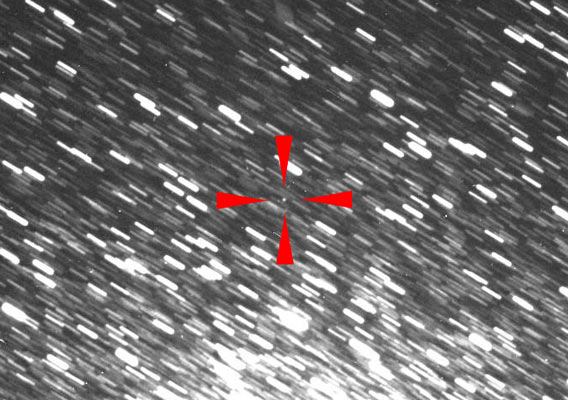Watch Asteroid 2012 DA14 Live As It Passes Earth

Image credit: Dave Herald
[NOTE: A huge meteor blazed over the skies of Russia last night, creating a massive shock wave that shattered windows across a big region and caused many injuries due to flying glass. I have a post up with what I knew as of about midnight Mountain time. I am fairly certain this has nothing to do with asteroid 2012 DA14, which I explain in that article. I'll post more when I find out more, so stay tuned here at Bad Astronomy.]
[Note: I’ll be doing a live web video chat during closest passage of DA14. Details are below.]

At 19:25 UTC today (2:25 p.m. Eastern US time), the asteroid 2012 DA14 will be at its closest approach to Earth. At that time, it will be about 27,000 kilometers (17,000 miles) above the surface of the Earth, give or take a few clicks. At 50 meters in diameter the asteroid will be dim even at that distance, only visible via binoculars or a telescope…and even then, you have to be on the right side of the Earth to even get a chance! That means eastern Europe, Australia, and Asia. It won’t be visible until nighttime in the US (of course), long after closest approach, but big ‘scopes will still get a view.
Happily, though, several observatories will be broadcasting live shots of the asteroid as it passes. I have a list below. But first, I want to reiterate that this rock will miss us, it poses no threat now or in the near-to-middling future, and that in fact this is a good thing. We get practice observing a small rock and getting a better orbit characterization for it, and it also raises public awareness that these suckers are out there and a potential threat.
Asteroid 2012 DA14 can be seen moving in the center of this animation comprised of observations by the Faulkes Telescope in Siding Springs, Australia. Taken on Feb. 14, these images show the rock when it was still 750,000 km (465,000 miles) from Earth. The streak in one frame is most likely a satellite caught in the telescope's field of view. Image credit: LCOGT/Faulkes
I wanna see it!
OK, so here’s how you can watch online. Mind you, even in the biggest telescopes, 2012 DA14 will only be a dot (even Hubble would only see it as a couple of pixels across), so don’t expect Hollywood-type footage here. But still, this’ll be pretty cool.
- First, I will be doing a live video Hangout on Google+ starting at 19:00 UTC (14:00 Eastern US time) where I’ll talk about this asteroid, the danger of impacts, and take questions from y’all. I won’t have the URL until the Hangout actually starts, but when I do I’ll post it in my G+ stream, as well as on Twitter and Facebook. I should be able to feed in the live streams listed below as well as pictures as they come in, so you can come watch and ask me questions live. In fact, I’ll embed the video here so you can simply watch it all right here on the blog.
[If you are reading this sentence, the webcast hasn’t started yet! I’ll replace this line with the video when the time comes.]
- NASA will be streaming live views on UStream and on NASA TV starting about a half hour before closest approach.
- They’ll also have a live view from Marshall Space Flight Center starting around 23:00 UTC (18:00 Eastern).
- The Massachusetts-based Clay Center Observatory will have a live stream once the Sun sets there, starting around 23:00 UTC (18:00 Eastern). High school students will be running the telescope, which is pretty awesome.
- The Virtual Telescope Project will have a live feed starting at 22:00 UTC (17:00 Eastern). They have a handy countdown clock on their site, too.
- The Israeli Baraket Observatory has a live feed starting at 20:15 UTC (15:15 Eastern), with still images updating once or twice a minute.
- The Planetary Society will be doing a webcast that will include live telescope feeds and other goodies.
- Bayfordbury Observatory in the UK says they will live-tweet images as they get them, finishing up around 22:00 UTC.
Enjoy this! Near-Earth asteroid passes are random, so there may not be another this close for decades, or there may be another one in a week. We don’t know, so keep your eyes open and rest assured that if we know about one in advance, I’ll be talking about it here.

